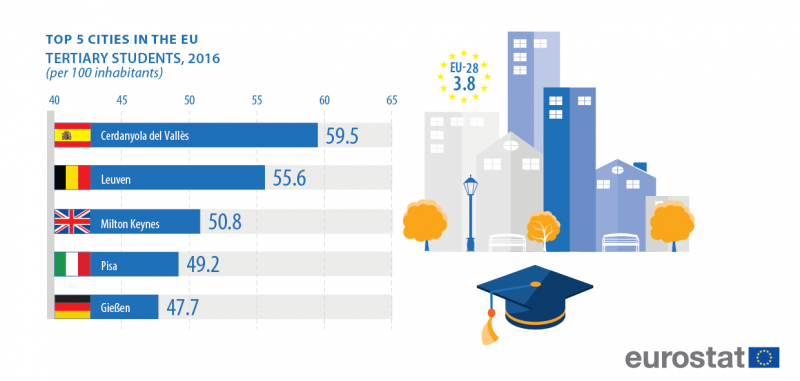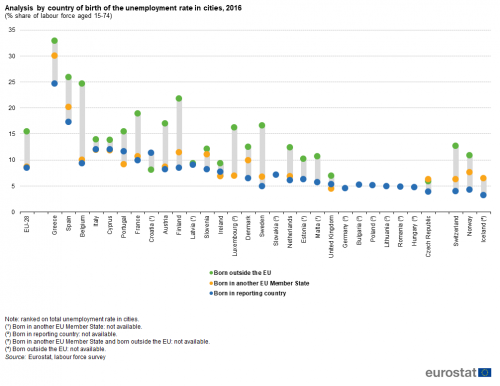Archive:Statistics on European cities
Data extracted in March 2018.
Planned article update: September 2019.
Highlights
The highest young-age dependency ratio for cities in the EU was recorded in the Communauté d’agglomération Val de France, situated close to Paris (58.4 %).
Citizens of other EU Member States accounted for more than one fifth of the total population living in the Belgian capital city, Bruxelles / Brussel.
More than half the world’s population resides in urban areas, and cities continue to attract an increasing share of the people in search of a job and an improved quality of life. Indeed, cities are often seen as centres of economic growth, providing opportunities for study, innovation and employment; poles of economic activity that attract a broad spectrum of people (be they national or international migrants). This is particularly true for capital cities, which are often characterised by particularly high concentrations of economic activity, employment and wealth.
Full article
Yet, there is often a paradox insofar as some cities also display very high levels of social exclusion, unemployment and income disparity, while many cities are confronted by issues such as crime, traffic congestion or pollution. Furthermore, within individual cities it is possible to find people who enjoy a very comfortable lifestyle living in close proximity to others who may face considerable challenges — herein lies the ‘urban paradox’.
An increasing share of the European Union (EU’s) population live and work close to cities and it is widely expected that this pattern will continue in the future, as economic activity is consolidated in and around urban areas. There is however a diverse mix of cities in the EU: at one end of the scale are the global metropolises of London and Paris (with close to 10 million inhabitants), while at the other end, approximately half of the cities in the EU had a relatively small urban centre of between 50 and 100 thousand inhabitants. Although population numbers in and around some of the EU’s largest cities are often growing at a fast pace, especially when taking into account their surrounding suburbs, there are other cities in the EU, for example, those characterised by their location in former industrial heartlands, where population numbers are in decline.
This expansion of population numbers both within and around some of the main metropolises in the EU — sometimes referred to as urban sprawl — is accompanied by a range of complex challenges: for example, issues relating to sustainability, social cohesion, an ample supply of housing, or the provision of efficient transport services. This article focuses on three areas: demographic developments (including a special focus on migrants); education and labour markets (including an analysis of the transition from unemployment to employment); and the living standards enjoyed by those living in cities (including information on the risk of poverty or social exclusion and housing costs).
Population
Population statistics for cities refer to the total number of inhabitants according to their usual residence, in other words, the place where a person normally lives, regardless of temporary absences; this is generally their place of legal or registered residence. Population numbers are a reference for measuring the general size of an urban entity and are used as a denominator for many derived indicators.
Young-age dependency ratios
Map 1 provides information on the age structure of 925 cities in the EU, Norway and Switzerland. The size of the circles shows how large each city is in terms of its overall number of inhabitants, while the shading reflects the young-age dependency ratio, in other words the ratio between the number of young people aged 0-19 years and the number of working-age people (defined here as persons aged 20-64 years).
Across the EU-28 as a whole, the young-age dependency ratio was 34.7 % in 2016. The age structure of EU cities was somewhat skewed insofar as 552 recorded ratios that were below the EU-28 average, compared with 356 that had higher than average young-age dependency ratios. These figures are influenced, at least to some degree, by fertility patterns, with falling crude birth and fertility rates often associated with a decision to delay parenthood, have smaller families or have no children. This pattern may be particularly common in cities which are characterised by large student populations or cities which attract graduate labour, as these young people are more likely to choose to delay parenthood in order to first establish a career.
Cities with the highest young-age dependency ratios were often characterised by relatively large populations of manual workers and/or migrant populations
Young-age dependency ratios were relatively high in most cities across the Benelux countries, France and the United Kingdom. In contrast, the lowest ratios tended to be recorded in cities located in eastern and southern part of the EU, as well as in Germany and Austria.
A closer analysis reveals that many of the cities with particularly high shares of young persons (relative to their working-age populations) were characterised as suburban areas around some of the EU’s largest cities or more provincial areas with relatively high shares of manual workers and/or net inward migration. There were 11 cities in the EU which recorded young-age dependency ratios of at least 50.0 % — in other words, the population structure was such that there were fewer than two people of working-age for each young person aged less than 20 — eight of these were located in France (2014 data), while the other three were in the United Kingdom (2016 data).
The highest young-age dependency ratio (58.4 %) was recorded in the Communauté d’agglomération Val de France, situated to the north of the French capital, while each of the remaining French cities were also located relatively close to the capital, namely, Saint Denis and Creil (both also to the north of Paris), the Communauté d’agglomération Lacs de l’Essonne, Sénart en Essonne and Evry (to the south), and Mantes en Yvelines and Communauté de communes des Coteaux de Seine (to the west). The highest young-age dependency ratio in the United Kingdom was recorded in Bradford (Yorkshire; 51.1 %), while the other cities where there were fewer than two working-age adults for each young person aged less than 20 were Blackburn with Darwen (to the north of Manchester) and Slough (to the west of London). Many of these cities in France and the United Kingdom were characterised by a relatively high share of migrants within their total populations.
These developments were synonymous with more general patterns, insofar as the 52 cities with the highest young-age dependency ratios in the EU were all located in either France or the United Kingdom (if excluding the atypical case of the autonomous Spanish city of Melilla). Outside of these 52 cities in France or the United Kingdom, the highest young-age dependency ration was in Greater Ede (to the east of Utrecht in the Netherlands).
At the other end of the range, the vast majority of the 307 cities across the EU with young-age dependency ratios that were less than 30.0 % were located in Germany (88 cities), Poland (50), Italy (45), Romania (35) and Spain (32), while Bulgaria was the only other EU Member State to record a count that was in double-digits (11 cities).
Looking in more detail, the lowest young-age dependency ratios in the EU were recorded in two German university cities, namely, Greifswald (in north-east Germany; 21.7 % in 2014) and Würzburg (northern Bavaria; 21.7 % in 2015). They were followed by two cities in Romania — Brasov (central Romania; 22.1 % in 2015) and Braila (eastern Romania; 22.3 % in 2015) — and the Italian city of Cagliari (which is on the southern coast of Sardinia; 22.6 % in 2015). It is also interesting to note several atypical cases, for example, the university city of Leuven (29.6 % in 2015) was the only city in Belgium, the capital city of København was the only city in Denmark (27.7 % in 2013), and the Scottish cities of Aberdeen and Edinburgh were the only cities in the United Kingdom to report young-age dependency ratios that were less than 30.0 %.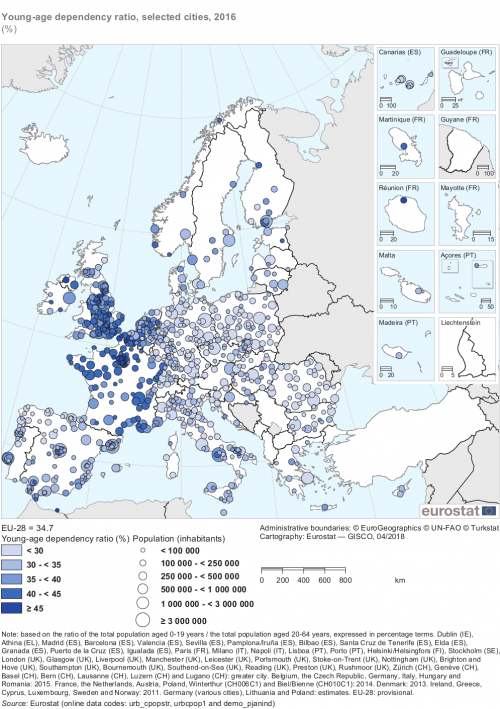
(%)
Source: Eurostat (urb_cpopstr), (urbcpop1) and (demo_pjanind)
People living in capital cities
Figure 1 presents the structure of the resident population as of 1 January 2015 for four capital cities in the EU. These population pyramids contrast the proportion of people living in each city centre with the broader measure of people living in the surrounding commuter zone (known as the functional urban area).
The Slovenian and British capital cities appear to exert a considerable pull on relatively young working-age people, possibly reflecting employment and lifestyle opportunities
A functional urban area consists of a city and its surrounding commuting zone. On this basis, London (the capital city of the United Kingdom) was by far the most populous city in the EU, with 12.1 million inhabitants in 2015; for comparison there were 4.5 million people living in the Italian capital of Roma and its surrounding commuter zone. Bratislava (Slovakia) and London both reported a relatively high share of their populations being composed of working-age persons between 25 and 44 years, whereas in Roma, it appeared the largest age groups were slightly older, between 35 and 54 years.
A more detailed analysis of the population structure reveals that more than half of the total number of inhabitants in the Belgian capital city of Bruxelles / Brussel were living in the surrounding commuting zone. This could be contrasted with the situation in London, where more than 70 % of the population were living in the greater city. It is also interesting to note that in Bratislava and Roma, it was relatively common for elderly generations to be living in the city, while the elderly in Bruxelles / Brussel were more likely to be living in the commuting zone.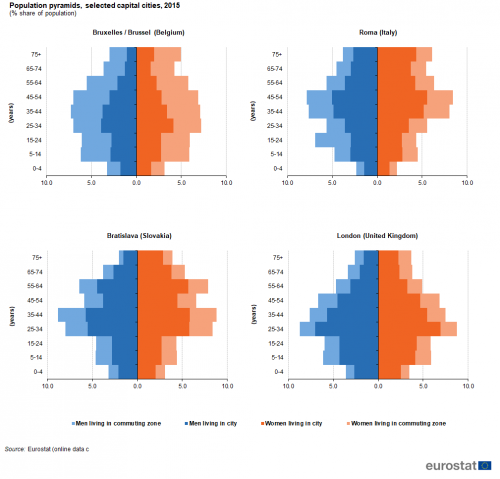
(% share of population)
Source: Eurostat (urb_cpop1) and (urb_lpop1)
Migrants living in cities
Migration is a long-standing phenomenon, however, it is only since the middle of the last century that Europe has undergone a shift from being a region of net emigration to a region characterised by net immigration. Many European cities play an important role in relation to the perception of migrants through their mix of multicultural and ethnically diverse populations.
Cities are often characterised as places where migrants and non-migrants interact, through work, study, or raising their families. While cities can offer considerable opportunities for migrants, they may also face considerable challenges regarding integration and/or inclusion. Indeed, one of the European Commission’s main priorities is to better manage migration. In this context, the integration and social inclusion of the growing number of migrants settling in Europe is key, whether they originate from other EU Member States or further afield.
Citizens from other EU Member States accounted for more than one fifth of the total population living in the city of Bruxelles / Brussel (the Belgian capital)
Figure 2 provides an alternative analysis concerning the structure of urban populations, detailing the cities and functional urban areas in the EU with the highest shares of EU and non-EU foreign citizens in 2016 (note the latest reference year available varies considerably for some EU Member States).
In Derry and Strabane (Northern Ireland, the United Kingdom) almost half (44.7 %) of the total number of inhabitants living in the urban centre were citizens of other EU Member States. By contrast, in its broader functional urban area (in other words, including the surrounding commuter zone), the share of migrants from other EU Member States in the total number of inhabitants was just 2.1 %. This pattern was relatively common, insofar as migrants tend to live in city (centres).
The second highest share of citizens from other EU Member States was also recorded in Northern Ireland, namely in the capital of Belfast, where just over 1 in 4 (25.4 %; 2011 data) of the city’s population was a foreign citizen from another EU Member State. The relatively high share of foreign EU citizens living in the southern Spanish city of Fuengirola (22.5 %; 2016 data) may be attributed, at least in part, to a high number of retirees. The next highest shares were recorded in the Belgian capital of Bruxelles / Brussel (22.2 %; 2015 data) and the central German city of Offenbach am Main (18.8 %; 2015 data), which had a relatively large number of Greek, Romanian, Polish and Italian migrants (as well as a high number of migrants from outside the EU). Note that the high share of non-EU migrants living in the Baltic Member States may, at least in part, be attributed to former Soviet Union citizens who are permanently resident.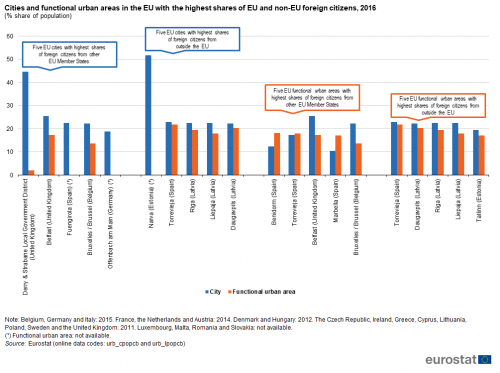
(% share of population)
Source: Eurostat (urb_cpopcb) and (urb_lpopcb)
Education and employment
The Europe 2020 strategy is the EU’s growth and jobs strategy for the current decade, which aims to deliver smart, sustainable and inclusive growth. Within the context of education and employment, the strategy foresees increasing the EU-28 employment rate among persons aged 20-64 years to 75 %, cutting the proportion of early leavers from education and training to less than 10 %, and raising the share of people aged 30-34 years with a tertiary level of education to at least 40 %.
Tertiary students
Modern economies characterised by digital technologies, high skills and innovation are likely to require a growing number of qualified staff in the coming years; skills gaps already exist in some EU Member States and specific sectors. Europe’s future prosperity depends, at least to some degree, on nurturing more dynamic, high-achievers who can develop innovative products and processes.
More than half of the total number of inhabitants living near Barcelona in Cerdanyola del Vallès were tertiary students enrolled in higher education establishments
Map 2 shows the prevalence of tertiary education students relative to the total number of inhabitants for 810 cities across the EU. In 2015, there were, on average, 3.8 tertiary students enrolled in the EU-28’s higher education establishments for every 100 inhabitants. Unsurprisingly, the number of tertiary students relative to population size was skewed in favour of cities, with this ratio often rising considerably higher in many of the EU’s most famous university cities. These cities with relatively large student populations were widely dispersed across the EU’s territory, from Coimbra and Porto in Portugal through Innsbruck in Austria to Kraków and Rzeszów in Poland or from Oxford in the United Kingdom through Gent and Leuven in Belgium and Heidelberg in Germany to Cluj-Napoca in Romania.
There were 23 cities in the EU where there the student population in tertiary education accounted for at least one quarter of the total number of inhabitants. These were primarily located in Germany (seven cities), Spain (four), Italy (three), Belgium, Portugal and the United Kingdom (two cities each), while the list was completed by individual cities from each of Austria, Poland and Slovakia. Looking in more detail, there were three cities where the ratio of higher education students to the total resident population was at least 50.0 %: Cerdanyola del Vallès in Spain (home to the Universitat Autònoma de Barcelona); Leuven in Belgium (home to the Katholieke Universiteit and technical universities); and Milton Keynes in the United Kingdom (home to the Open University and Cranfield University among others) — it should be noted that only a very small proportion of the students registered with the Open University are in fact resident in Milton Keynes.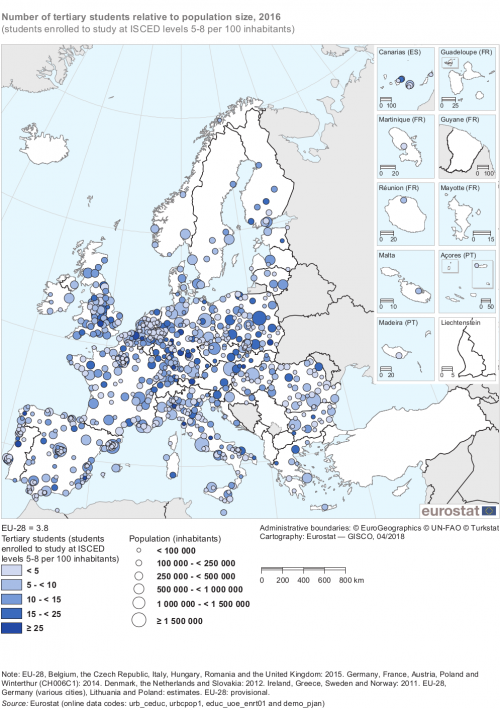
(students enrolled to study at ISCED levels 5-8 per 100 inhabitants)
Source: Eurostat (urb_ceduc), (urbcpop1), (educ_uoe_enrt01) and (demo_pjan)
The transition from unemployment to employment
In a majority of the eastern EU Member States, cities generally tended to outperform rural areas economically and record some of the highest rates of growth for their economic performance. By contrast, in some western Member States — for example, Belgium, France or the United Kingdom — it was common to find a number of cities ‘left behind’ by globalisation; places that industrialised early on in the industrial revolution but which have not fully adapted when their traditional activities moved elsewhere or were replaced by new technologies. Many of these cities are characterised by persistent pockets of long-term unemployment, high levels of poverty and people living in social exclusion.
Figure 3 shows an analysis by degree of urbanisation, illustrating one aspect of labour market flexibility, namely, the share of the adult population (people aged 15-74 years) that was able to move out of unemployment into a job during the course of 2016. In most western and southern economies of the EU, people living in cities faced the greatest difficulties in moving out of unemployment into work. When compared with people living in rural areas, the difference was particularly acute in Austria, France, Portugal, Spain and Greece, as well as Slovenia.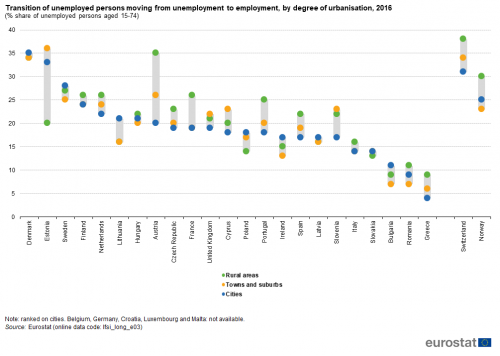
(% share of unemployed persons aged 15-74)
Source: Eurostat (lfsi_long_e03)
Unemployment in cities
Figure 4 focuses on unemployment rates exclusively in cities, with an analysis by country of birth. In 2016, the total unemployment rate in the EU-28 was 9.1 %, with slightly lower rates for people born in the reporting country (8.4 %) and people born in another EU Member State (8.6 %). By contrast, the EU-28 unemployment rate was much higher among people born outside the EU (15.4 %).
In Ireland, Italy, Cyprus, Portugal and the United Kingdom, the unemployment rate in cities was lower among people born in another EU Member State than it was for nationals
This pattern — higher unemployment rates in cities for people born outside the EU — was repeated in the vast majority of the EU Member States for which data are available. In 2016, the only exceptions were Croatia and the Czech Republic: for the former, the unemployment rate among people born outside the EU (8.0 %) was lower the rate for people born in Croatia (11.3 %); for the latter, the unemployment rate among people born outside the EU (5.8 %) was lower than the rate for people born in another EU Member State (6.2 %).
The biggest differences (in percentage point terms) between unemployment rates in cities for people born outside the EU and people born in the reporting country were in Belgium, Finland and Sweden. The relatively high levels of social exclusion witnessed among city-dwellers in some northern and western EU Member States may, at least in part, reflect a lack of capacity to assimilate migrants from non-member countries into the labour market.
It is also interesting to note that in five of the EU Member States — Italy, Cyprus, the United Kingdom, Ireland and Portugal — the unemployment rate in cities for people born in another EU Member State was lower than the rate for people born in the reporting country.Living conditions
One of the five headline targets for the Europe 2020 strategy is to reduce poverty in the EU by lifting at least 20 million people out of the risk of poverty or social exclusion by 2020. The same indicator is also used within the sustainable development goals (SDGs) and to track the progress being made in relation to the European pillar of social rights, which aims to build a more inclusive and fairer EU.
People living at risk of poverty or social exclusion
In 2016, almost one quarter (23.5 %) of the EU-28 population was living at risk of poverty or social exclusion. An analysis by degree of urbanisation (see Figure 5) reveals that people living in towns and suburbs had the lowest risk of poverty or social exclusion (21.6 %), a share which was 23.6 % for city-dwellers and peaked at 25.5 % among people living in rural areas. These figures reflect the growing number of people living in suburban areas, within relatively close reach of urban centres, while potentially having more space, less noise, less pollution and lower costs.
In western EU Member States, the risk of poverty or social exclusion tended to be higher in cities, whereas in eastern Member States it was usually higher in rural areas
A closer examination reveals that in half (14) of the EU Member States, the highest proportion of people at risk of poverty or social exclusion was recorded in rural areas. More than half of the rural population was at risk of poverty or social exclusion in 2016 in Bulgaria and Romania. There were eight Member States where the share of the rural population at risk of poverty or social exclusion was within the range of 30.0-40.0 % — Greece, Lithuania, Latvia, Croatia, Spain, Cyprus, Hungary and Italy. As such, those Member States with relatively high shares of their rural populations living at risk of poverty or social exclusion were located exclusively in the Baltic Member States, eastern or southern parts of the EU.
By contrast, the rural populations of Germany, the United Kingdom, the Netherlands, Belgium, Denmark, Austria and Malta (note the data for rural areas is of low reliability) were much less likely to be at risk of poverty or social exclusion than people living in cities. As such, western European cities were often characterised by an urban paradox, insofar as while they generated high levels of wealth, they also reported that relatively large shares of their populations were living with the risk of poverty or social exclusion.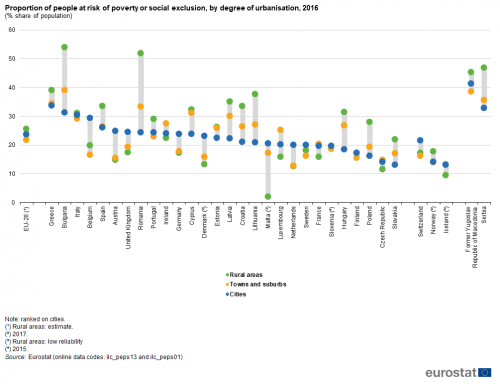
(% share of population)
Source: Eurostat (ilc_peps13) and (ilc_peps01)
Housing costs
Real estate prices and rents vary considerably, not just between and within EU Member States, but also at a more local/regional level. Nevertheless, housing is often the largest single item in a household budget, irrespective of whether the occupants are paying off a mortgage/loan or renting a property.
People living in cities often paid a premium for living centrally or in a particular borough/district; this meant they were more likely to face a considerable burden from the cost of their housing
The housing cost overburden rate is defined as the share of the population that is living in a household where total net housing costs were greater than 40 % of disposable income. The EU-28 housing cost overburden rate averaged 11.1 % in 2016: an analysis by degree of urbanisation reveals that thus burden was lowest in rural areas (8.6 %), with a slightly higher rate recorded for people living in towns and suburbs (10.2 %) and a peak among those living in cities (13.5 %). Note that people living in cities are often prepared to pay more for less space in order to live centrally or in a borough/district with particular amenities or transport connections. This pattern has led to the gentrification (displacement of lower-income families as a result of rising property prices) of some inner cities and considerable changes in their demographic and social make-up, with young, upwardly mobile professionals moving into regenerated housing stock, often crowding out the indigenous population. In a similar vein, popular rural or coastal locations can also see their property prices rise at a rapid pace, especially when supply is constrained by local planning authorities seeking to maintain the original charm of an area.
In five EU Member States — Greece, Bulgaria, Romania, Germany and the United Kingdom — the share of the rural population in 2016 that was overburdened by the cost of housing was in double-digits (10 % or higher); particularly high rates were observed in Greece and Bulgaria.
By contrast, there were seven EU Member States where a double-digit share of the population living in towns and suburbs was overburdened by housing costs, with Greece again recording a particularly high share. The share of the population living in cities that was overburdened by housing costs exceeded 10 % in Member States, including all five that registered double-digit shares for their rural populations and again lead by Greece; they were joined by Denmark, Belgium, the Czech Republic, Luxembourg, the Netherlands, Italy, Austria, Spain, Slovakia (2015 data) and Sweden.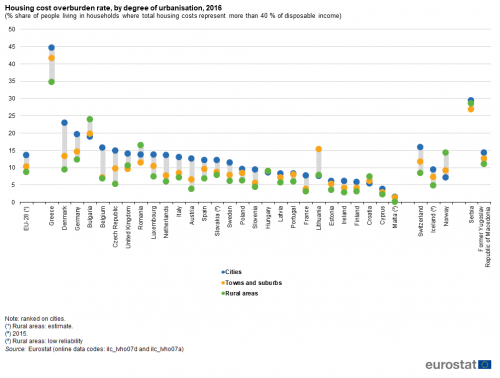
(% share of people living in households where total housing costs represent more than 40 % of disposable income)
Source: Eurostat (ilc_lvho07d) and (ilc_lvho07a)
Feeling safe in capital cities
The final analysis in this section concerns information from a perception survey. Figure 7 presents data for capital cities in the EU and details the answers given by respondents when queried about how safe they felt in the neighbourhood where they live. In 2015, the highest shares of positive replies (people who strongly agreed or somewhat agreed that their neighbourhood was safe) were recorded in the Nordic capitals of Stockholm (96 %), København (95 %) and Helsinki / Helsingfors (also 95 %); note that slightly higher shares were recorded in the capital cities of the two Nordic non-member countries shown in the figure, with 98 % feeling safe in Oslo and 97 % in Reykjavik. In the vast majority of the other EU Member States, at least three quarters of the population agreed that they felt safe in their neighbourhood, as was also the case in the Turkish capital city (Ankara). However, lower shares were recorded in the Greek, Bulgarian and Italian capital cities, as the share of people feeling safe fell to less than two thirds of the population in Athina (64 %), Sofia (63 %) and Roma (60 %).
(% share of total)
Source: Eurostat (urb_percep)
Source data for figures and maps
Data sources
Eurostat’s data collection on cities (formerly known as the Urban Audit) is undertaken by national statistical authorities, the Directorate-General for Regional and Urban Policy (DG REGIO) and Eurostat. It provides statistics on a wide range of socioeconomic indicators that cover many aspects that relate to the quality of urban life: demography, housing, health, economic activity, the labour market, income disparities, educational qualifications, the environment, climate, travel patterns, tourism and cultural infrastructure. The latest data collection exercise sought information from almost one thousand different European cities (across EU Member States, Norway, Switzerland and Turkey), each with a population of at least 50 thousand inhabitants in their urban centre; note that there may be considerable differences in relation to the latest reference period available for each city.
The urban statistics presented in this article relate to three different concepts: the majority of the data presented refer to cities (one or more local administrative unit (LAUs) where the majority of the population lives in an urban centre of at least 50 thousand inhabitants), although the concepts of the greater city (an approximation of the urban centre when this stretches beyond the administrative city boundaries) and the functional urban area (a city plus its surrounding commuting zone) are also employed. The information presented has been adapted to reflect the most appropriate definitions, whereby information on greater cities is preferred when reflecting cases where a relatively high share of the population lives outside of the administrative boundaries of the urban centre (for example, the Greek capital of Athina).
The Directorate-General for Regional and Urban Policy conducts a perception survey every three years in the EU Member States, Iceland, Norway, Switzerland and Turkey; the latest survey was conducted in June 2015 and covered 79 different cities. These surveys cover a range of issues, including: employment, the environment, housing, transport, culture, city services and immigration.
For more information:
Context
The Europe 2020 strategy is the EU’s growth strategy for the period through to 2020: it aims to support the recovery from the global financial and economic crisis through smart, sustainable and inclusive growth. To deliver the Europe 2020 targets through economic, social and environmental initiatives in cities and urban areas, policymakers have acknowledged the need to mobilise multi-level governance structures whereby local and regional actors are involved in policy design and delivery alongside central government. The Europe 2020 monitoring platform is a network of 178 cities and regions coordinated by the European Committee of the Regions, which monitors the involvement of EU local and regional authorities in the European semester and the Europe 2020 strategy.
The European Commission’s Directorate-General for Environment (DG Environment) works on a range of issues with the goal of improving urban environments, for example:
- the United Nations (UN) sustainable development goals, in particular goal 11, which seeks to ensure that all cities are inclusive, safe, resilient and sustainable;
- EU environmental legislation which aims to guarantee that EU residents may live and work in cities that provide clean air and water, avoid exposure to excessive noise, and deal properly with waste, while protecting nature and biodiversity, and promoting green infrastructure;
- the European green capital initiative, which allows cities to showcase their environmental performance, recognising and rewarding local efforts to improve the environment, the economy and the quality of life in cities (the Dutch city of Nijmegen was the winner of the 2018 award);
- the European green leaf initiative, which allows towns and smaller cities (of between 20 and 100 thousand inhabitants) to be recognised for their commitment to better environmental outcomes, with a particular accent on efforts that generate green growth and new jobs (the Belgian city of Leuven and Swedish city of Växjö were jointly named as winners of the 2018 award).
Cities and urban areas are at the heart of the EU’s cohesion policy. At least half of the resources associated with the European Regional Development Fund (ERDF) during the period 2014-2020 will be invested in urban areas. One of the main areas concerns integrated strategies for sustainable urban development (allocated around EUR 10 billion), whereby around 750 cities across the EU will be empowered to implement strategies that touch upon various dimensions of urban life, including: urban renewal, education, economic development, social inclusion and environmental protection. These initiatives are intended to provide a stimulus for tackling issues such as demographic challenges, job creation, social inclusion or the impact of climate change, all of which are critical for achieving the smart, sustainable, inclusive society envisaged in the Europe 2020 strategy.
The EU’s urban agenda was launched in May 2016 through the Pact of Amsterdam. It is based on three pillars, namely, to deliver better regulation, better funding and better knowledge. The urban agenda is founded on cooperation between cities, EU Member States, the European Commission and other stakeholders to stimulate growth, living standards, the quality of life and innovation in European cities. To deliver these goals, 12 different partnerships have been identified to coordinate actions; within the context of this article the most relevant concern:
- the inclusion of migrants and refugees (to propose and implement ways for better managing the integration of migrants and refugees, with particular importance given to the challenges and needs of cities);
- jobs and skills in the local economy (to deal with economic performance and business development at a local level, essential components for sustainable development and social cohesion);
- urban poverty (to contribute to better policies which impact on the inclusion of vulnerable groups and the regeneration of deprived neighbourhoods);
- housing (as affordable housing is a basic human right and fosters social cohesion, this partnership aims to contribute better policies and frameworks to stimulate access to adequate housing).
The European Commission’s Agenda on migration (COM(2015) 0240 final) set out a European response providing immediate actions in relation to the plight of thousands of migrants putting their lives in peril to cross the Mediterranean in 2015 and 2016. It also provided a range of longer-term policy solutions to manage migration in the EU better, based on: reducing the incentives for irregular migration; border management — saving lives and securing external borders; a common asylum policy; and a new policy on legal migration.
The ERDF supports the integration of migrants through various measures such as: investment in social, health, education, housing and childcare infrastructure; the regeneration of deprived urban areas; actions to reduce spatial and educational isolation of migrants; or initiatives around business start-ups for migrants. Funding from the ERDF has also been used to help tackle the migration challenge in terms of emergency measures, such as providing support to establish reception centres and shelters for migrants and asylum-seekers.
Direct access to
- European cities - spatial dimension (background article)
- Rural areas in the EU
- Territorial typologies for European cities and metropolitan regions (background article)
- Urban Europe — Statistics on cities, towns and suburbs (online publication)
- Eurostat regional yearbook
- Urban Europe — Statistics on cities, towns and suburbs — 2016 edition
- Sustainable Development in the European Union — Monitoring report on progress towards the SDGs in an EU context — 2017 edition
- Quality of life in European cities 2015 — Perception survey in 79 European cities — European Commission, Flash Eurobarometer 419, January 2016
- Quality of life in cities 2012 — Perception survey in 79 European cities — European Commission, Flash Eurobarometer 366, October 2013
- Urban audit (urb), see:
- Cities and greater cities (urb_cgc)
- Functional urban areas (urb_luz)
- Perception survey results (urb_percep)
- A harmonised definition of cities and rural areas: the new degree of urbanisation — European Commission — 2014
- Cities in Europe — The new OECD-EC definition — European Commission — 2012
- Degree of urbanisation classification
- Metadata on city statistics (ESMS metadata file — urb_esms)
- Methodological manual on city statistics — Eurostat — 2017
Maps can be explored interactively using Eurostat’s statistical atlas (see user manual).
This article forms part of Eurostat’s annual flagship publication, the Eurostat regional yearbook.
